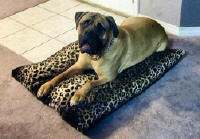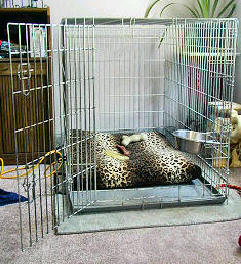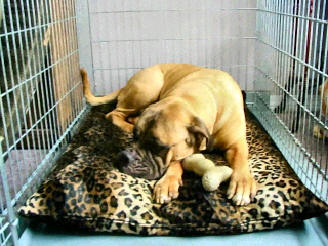 |
||||||
Crate Training Your Adult Bullmastiff What you need:
Determining what crate size you will need: If your Adult Bullmastiff has never used a crate before, I have found the easiest crate to use is a high quality wire crate that is based on the following dimensions:
I like to use crates that are large enough for the Bullmastiff to move around easily and to be able to stand up or sit in the crate without hitting their head on the top of the crate.
The more comfortable your Bullmastiff feels in the crate, the easier it will be to crate train him/her. All Bullmastiffs like a cool spot to sleep, soft bedding, something to chew on, and water nearby. Day One Step one:
Set the crate up in either the same bedroom you sleep in or in an area where the entire family frequents often (like the living room). Make sure the crate is not positioned in a manner where the Bullmastiff inside the crate is able to see you leave the house (this is normally what triggers separation anxiety attacks) from a door or window. Make sure the crate is properly put together and sturdy. Inside the crate put in the soft orthopedic mat (or a thick blanket) to lay on, the Bullmastiff’s favorite toys, and a hanging bowl of fresh water. Leave the crate door open. Remove all other water bowls in the house. If the Bullmastiff wants to drink, they have to do it from the crate from here on out. Step Two: Sit down and relax in the same room as the crate. Your Bullmastiff will have a natural interest as to why all of their stuff is in this crate. Allow them to sniff around the crate and go in/out at their leisure. Each time they go in, tell them softly “good boy/girl”. Give them a small treat while they are inside the crate. Leave the crate door open. Allow this to continue for about 1-3 hours. Step Three: If you started in the morning, make ½ the amount of normal breakfast for your Bullmastiff using the same bowl hanging in the crate. You have two options to try based on the following:
Once the meal is done, pick up the bowl and put water back into the bowl and back into the crate. Leave the crate door open and make sure the Bullmastiff has full access to the crate throughout the house. Go about the rest of your morning as usual. Step Four: If you fed ½ portion of breakfast, your Bullmastiff will be hungry again in about 4 hours. Pull out the chicken-n-cheese bone. Let him/her sniff the bone to get them interested – but don’t let them have it. Go back to the crate and say the same command you did this morning “crate” and toss the bone into the back of the crate. He/she should dive right in. This time close the door behind them and allow your Bullmastiff to eat the bone until it looks like they are almost done. Stay in the room, but walk away from the crate. It should take them about 10 minutes. Open the crate door back up. They will either get up with the bone and leave or stay in the crate to finish the bone. Leave the crate door open at all times. Go about your day as usual. Step Five: Dinner time. Stand on the opposite corner of the open crate door and give your Bullmastiff the command “crate”. As you say that command drop a piece of kibble into the back of the crate (make sure your Bullmastiff is paying attention). If they go in to get the kibble – great. If not, then use some vocal encouragement and drop one more piece of kibble. If they make an attempt to go in, tell him/her “good boy/girl” and drop one more piece of kibble in the back as they move in. Swiftly and softly close the door behind them as soon as three paws make it completely into the crate. You only get one shot. When your Bullmastiff is completely in, open the door slightly to put the dinner into the hanger. Let them eat and keep the crate door closed. Walk away from the crate and do not leave the room. When he/she is finished eating, open the crate door and give them lots and lots of vocal and petting praise. Pick up the dish and put water back into it. Leave the crate door open. Go about your evening as normal. Step Six: Bedtime – if the crate is in the same room as where you sleep, give your Bullmastiff the command “crate” and drop a treat into the back of the crate. Once they are in, close the door and go to bed. If your Bullmastiff whines – ignore them. If they continue, give one stream squirt from the bottle. Do not say anything, just squirt once. I usually aim at their nose. They will quiet down for a second and will start again. Squirt once again. It usually takes about 4-5 attempts before they quiet down for the evening. If the crate is not in the bedroom, make plans to sleep out in the same room as the crate. Do the same as the above. Day Two Step Seven: As soon as you wake up, let your Bullmastiff out to use the bathroom. Leave the crate door open. Prepare breakfast and give the command “crate”. Your Bullmastiff should go right in. Put the food down and close the crate door. Walk in/out of the room while he/she is eating. When they are done, praise, and open the crate door. Put the water down as before and leave the crate door open. Step Eight: Throughout the day, call your Bullmastiff in to “crate.” Drop a small treat in the back of the crate to get them in. Only use the treats IF NECESSARY to get them in. Each time they crate, shut the door, and give them a treat. Walk out of the room. Count to 10. If you do not hear any whining, come back into the room and praise and give another treat. Stay in the room for 5 more minutes. Open the crate door and praise. Repeat Step Eight at least 4 more times during the day. Each time you walk out, extend the time to 30 seconds, 15 minutes, 1 hour, 2 hours. If he/she whines while in the crate, ignore them and keep the clock going. Only walk back into the room when they quiet down. Praise and give a treat each time, then let them out. Never give them praise or a treat while they are whining. Do not coddle them while they are whining. It will only encourage them to whine more. Step Nine: Repeat Step 5 from the day before. Step Ten: Repeat Step Six from the day before. Day Three This is usually the day you have to go to work. If not, continue Step Eight and keep extending the time up to 4 hours. Otherwise, feed breakfast in the crate as usual. Let him/her go potty and then put them back in the crate for 15 minutes. Let them out and leave the crate door open. Get ready for work and put water into the crate. Grab the Kong Toy and stuff the back of it with some small dog treats, then seal the large hole with Peanut Butter. Let your Bullmastiff sniff the final product and give the command “crate.” Once inside give them the Kong Toy, give soft praise, and leave the house very quietly. Come back at lunch to let them out to go potty and give them a little exercise to wear him/her out a bit. Then re-crate as mentioned above and go back to work.
Some dogs are easier to train than others. And sometimes it could take up to a week to get a Bullmastiff fully crate trained. However, if you use positive reinforcement and patience, it will be worth it. Always make sure that your Bullmastiff is not crated for more than 5 hours at a time (unless this is during normal nighttime sleeping). Otherwise, this will encourage your Bullmastiff to use the potty within the crate. This is a very bad habit to break once it starts, so do not encourage it to begin with.
After a week, if you are still having problems with crate training your Bullmastiff, then evaluate the following: Ø Is your Bullmastiff getting enough exercise? Walk your Bullmastiff in the morning before you leave for work to wear them out first, then crate them. Do the same when you come home from lunch to give them some exercise to stretch out. Ø Is the crate large enough? When your Bullmastiff stands up or sits down, does their head hit the top of the crate? Are they stooping down? If yes, then you probably have a crate that is too cramped for him/her. Ø Is the crate and crate bowl made out of stainless/galvenized steel? Some Bullmastiffs are allergic to plastics and if the crate is irritating their skin, they will not stay in the crate. Ø Did you provide comfortable bedding in the crate? Laying on a hard surface for hours can be quite uncomfortable and may make your Bullmastiff less willing to stay in the crate. Ø Are there chew toys inside the crate with your Bullmastiff? Chew toys give them something to do while inside the crate. Rotate the toys daily so that they don’t get bored with a particular toy. Ø Is there fresh water in the crate and is it securely attached to the crate at a comfortable drinking level? Bullmastiffs tend to drink more comfortably when the bowl is raised off of the crate pan. They also have less of a tendency to knock the bowl over when moving around. Ø Do you crate your Bullmastiff only when you leave the house or when you do not wan them around? If yes, stop it. Your Bullmastiff should not associate being crated with you leaving the house or leaving them. Instead your Bullmastiff should associate crating with eating, sleeping, when they want time alone, or when they want to play with their toys. Remember – Positive Reinforcement. Ø Is the crate fully accessible to your Bullmastiff at all times? It should be so that your Bullmastiff will associate the crate with being the one place in the house that they can claim as their very own. If the crate training is still not working out, consult a professional trainer that will be able to come to your house to assist you with crate training your Bullmastiff. Picture Contributions Marian is the Bullmastiff modeling proper use of a crate for a Bullmastiff. Crate training your Bullmastiff will save you a lot of heartache and expense. Bullmastiffs are den animals and the crate serves as the one private area they can call their own and use as refuge.
|
||||||

All
Rights Reserved. Copyright 1994 - 2001 BullmastiffInfo.org
|


 The
above methods has worked for me when working with adult rescues. I try to
use positive reinforcement so that the Bullmastiff will go into the crate
themselves. Otherwise, it would be very hard for me to physically push a
full grown Bullmastiff into a crate every time.
The
above methods has worked for me when working with adult rescues. I try to
use positive reinforcement so that the Bullmastiff will go into the crate
themselves. Otherwise, it would be very hard for me to physically push a
full grown Bullmastiff into a crate every time. If
your Bullmastiff is an escape artist and knows how to get out of a wire
crate. You should consider using a VariKennel Model 700 Airline Crate
with Dimensions: 48” x 32” x 35”. They are almost impossible to break
out of when securely put together. Be sure to put a fan in front of this
crate because it has a tendency to get too hot for a Bullmastiff to stay
in – even in an air-conditioned house. If you do not use A/C in your
house, then do not use this crate.
If
your Bullmastiff is an escape artist and knows how to get out of a wire
crate. You should consider using a VariKennel Model 700 Airline Crate
with Dimensions: 48” x 32” x 35”. They are almost impossible to break
out of when securely put together. Be sure to put a fan in front of this
crate because it has a tendency to get too hot for a Bullmastiff to stay
in – even in an air-conditioned house. If you do not use A/C in your
house, then do not use this crate.